As the brocade industry in Chengdu prospered and became an important way to increase fiscal revenue during the Western Han Dynasty, officials were sent to take charge of brocade production. Then, Jinguancheng, the residences of the officials in charge of brocade production, was built and its fame spread far and wide. As a result, the later generations referred whole Chengdu as “Jincheng” or “Jinguancheng”.
In the ancient times, as the brocade was finished, the workers would wash it in the river. Because of the large amount of brocade-cleaners, the river became flamboyant as brocade. So Jinjiang (literally means Brocade River) got its name.
Shu Brocade and Embroidery Museum is owned by Chengdu Shu Brocade and Embroidery Limited Corporation, which was previous Chengdu Shu Brocade Factory with a history of over 50 years. Being a unique pavilion with whole set loom for making brocade, Shu Brocade and Embroidery Museum settles down to researching silk, brocade and embroidery, copying and recovering Ancient Shu brocade, designing new type of brocade for decoration and exploring utilitarian function of Modern Shu Brocade. Shu Brocade Institution was honored with Sichuan Province Reputed Trademark & Sichuan Province Tourism Key Enterprise in 2008 and awarded as National Authorized Enterprise for Imparting Shu Brocade Weaving Technique by Ministry of Culture while weaving technique is listed in the first National Nonmaterial Cultural Heritage by State Council.
With an area of more than 3 thousand square meters, Shu Brocade and Embroidery Museum displaying over one thousand collections of different kinds of brocade and embroidery from different dynasties as well as various looms. Here you can touch the beauty of Shu brocade and embroidery across time and space.
Before you get down to the exhibition hall, you can see that a great demonstration of two skilled waver are operating a huge machine in the center of Shu Brocade and Embroidery Museum from the staircase. This machine is Shu Brocade Hualou Loom about 6 meter long, 1.5 meter wide and 5 meter high. Brocade can only be accomplished by two people who can cooperate harmoniously with each other. The waver staying in the upper loom is responsible for holding the warp threads under tension while the below waver loom is in charge of facilitating the interweaving of the weft threads. With a complicated and time-consuming process, man-made Shu Brocades are really produced to be amazingly exquisite and beautiful.
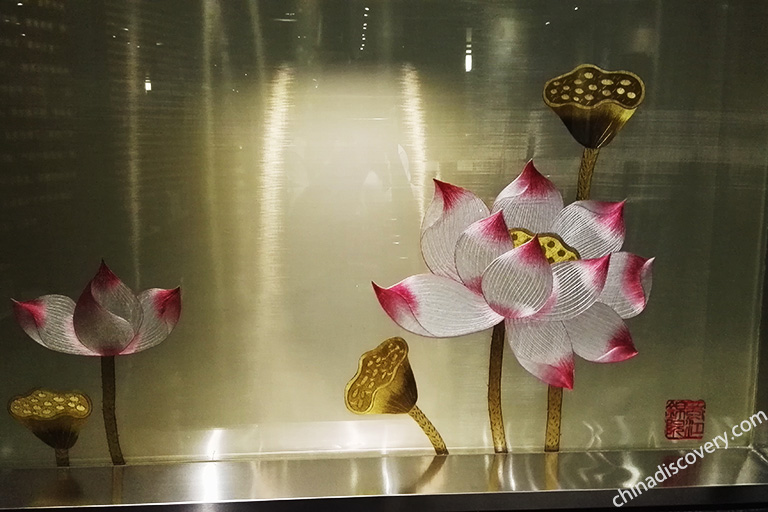 Collection in Shu Brocade and Embroidery Museum
Collection in Shu Brocade and Embroidery Museum
 Two Textile Workers are Weaving
Two Textile Workers are Weaving
The small path double lined on two sides with different images which describe the history and development of Shu Brocade. Being one of Four Great Brocade Schools together with Song Brocade, Yun Brocade and Zhuang Brocade, Shu Brocade is an important cultural heritage and one well-known traditional craftwork. There are replicas of numerous sorts of Shu Brocade from Spring and Autumn and Warring States Periods to Qing Dynasty in Shu Brocade and Embroidery Museum. What you can’t miss is the Three Wonders in Late Qing Dynasty, namely Shower Quilt Surface (雨丝被面), Yuahua Jin-silk (月华锦) and Square Jin-silk (方方锦) which combined traditional colorful and creative decoration arts, waved the various patterns in the rich hue and gentle halo, and made Shu Brocade gorgeously characteristic.
In the Shu Brocade and Embroidery Museum, you can also find images about the history of development of Shu Embroidery. The history of Shu Embroidery could tack back to ancient Shu Kingdom, because signs of Shu Embroidery were found in the Bronze Standing Figures unearthed in Guanghan Sanxingdui Site. It is well documented that Shu Embroidery was taking shape and thriving in Han Dynasty before reaching its climax in Tang Dynasty.
Shu Embroidery is one of four embroidery schools integrated with Su Embroidery in Jiangsu, Xiang Embroidery in Hunan and Yue Embroidery in Guangdong. From the display of Shu Embroidery and you can easily find that Shu Embroidery features free stitching, parallel and level and precise needle tracking, and gentle color. Its representative patterns are hibiscus and carps and pandas.
Style and color of Chinese Costume varies a lot from different dynasties and Shu Brocade and Embroidery Museum exhibits the changes in detail. With techniques of spinning, weaving and sewing clothing with the raw materials of hemp, animal hair and silk in the Neolithic Age, the ancestors contrived, people began to create the diversity of costumes until modern society.
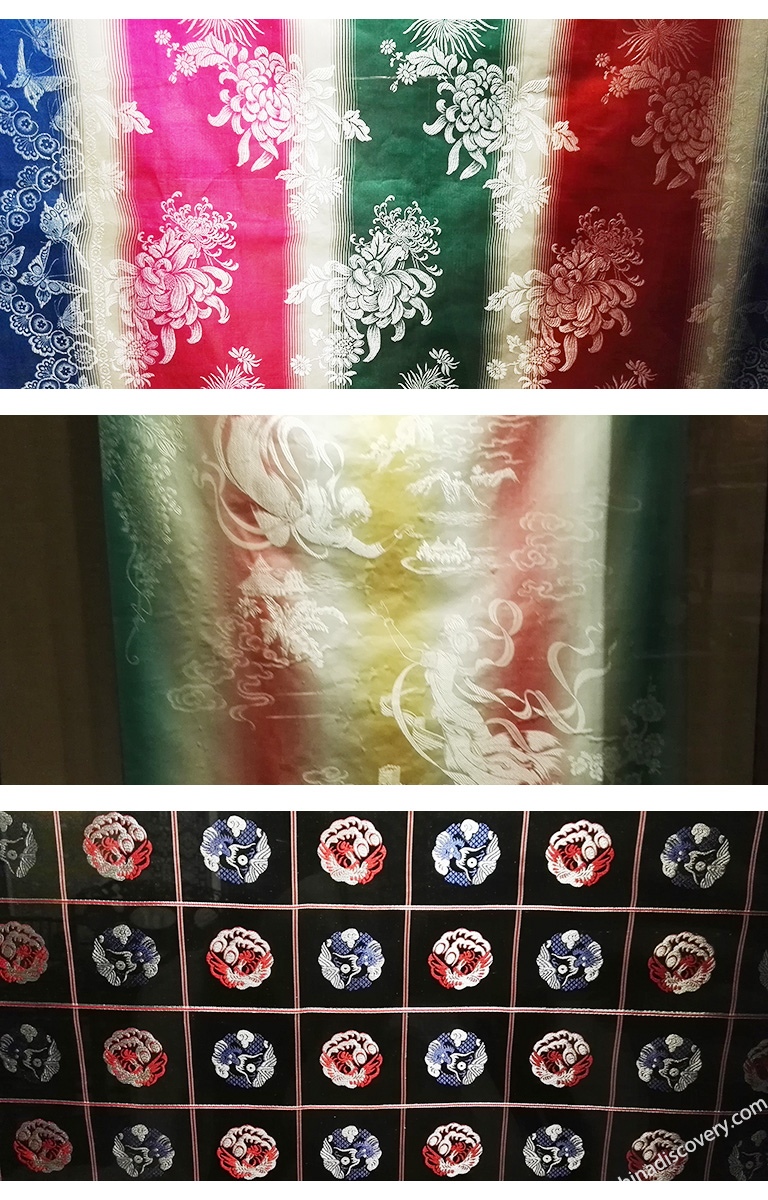 Three Wonders in Late Qing Dynasty
Three Wonders in Late Qing Dynasty
 Shu Embroidery of Panda
Shu Embroidery of Panda
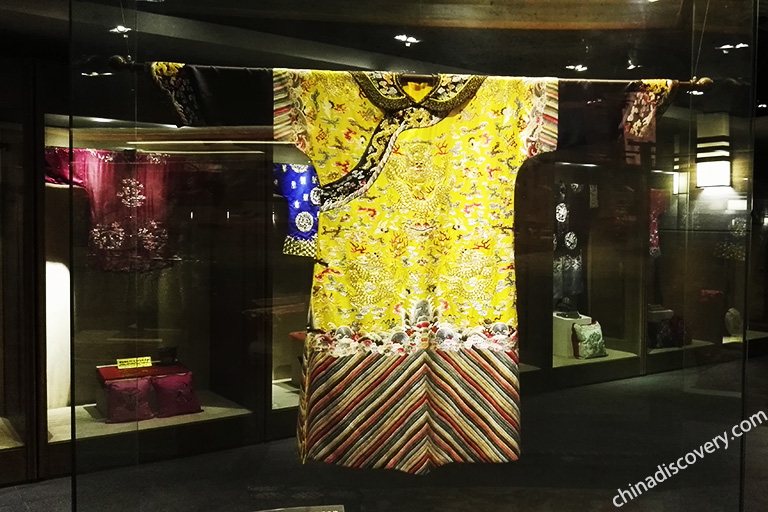 Traditional Chinese Costume
Traditional Chinese Costume
The Shu Brocade and Embroidery Museum is located in downtown area, between Chengdu Culture Park (Qingyang Palace) and Sichuan Museum, Du Fu Thatched Cottage and Huanhuaxi Park. You can easily get there by a taxi, bus. The nearest metro station is Qingyang Taoist Temple Station (青羊宫站) on Chengdu Metro Line 5.
If you want to get rid of hustle of public transportation, troublesome navigation and language communication, you can book a private tour package from China Discovery which covers sightseeing, dining and transfer from us. Our local tour guide and driver will escort you to Shu Brocade and Embroidery Museum and other attractions with speed and convenience, and take care of all the details. You just need to focus on sightseeing.
Travel Ideas: Shu Brocade and Embroidery Museum is a small cultural themed museum showing just a part of Chengdu. It's highly suggested to visit nearby attractions, in different types, to better understand Chengdu, including the Qingyang Palace (the largest & the oldest Taoist temple in Chengdu), Sichuan Museum (having Zhang Daqian Exhibition), Du Fu Thatched Cottage (learning Chinese traditional poem), Kuanzhai Alley (contrast of ancient and modern Chengdu).
 Kuanzhai Alley
Kuanzhai Alley
Chengdu is most known as "the Land of Abundance" in China, with three most representative brands: Giant Panda, leisure life and delicious food. Actually, there are more charm hidden in and around Chengdu, including the "Three Kingdom Culture", Sanxingdui civilization, brilliant UNESCO World Herigates. Once you come to Chengdu, you don't want to leave after you really into it.
During your Chengdu city tour, you can visit the Chengdu Panda Base in the morning to see the cute pandas, and visit other attractions in downtown, such as Renmin Park, Jinli Old Street, Kuanzhai Alley, Jinsha Site Museum, Chunxi Road, etc. Like local experience? Try a afternoon tea time in Renmin Park, or watch a Sichuan Opera Show in Shufeng Yayun Opera House, enjoy a cooking class in Sichuan Cuisine Museum. Your Chengdu tour can be interesting and relaxing.
★ Recommended Chengdu Tours :
With more time, travel beyond the city center to nearby Leshan to watch Leshan Giant Buddha and hike the Mount Emei, even you can go further to northwestern Sichuan to Jiuzhaigou Valley and western Sichuan for less-tourist but amazing beautiful scenery. China is vast and rich land, which offers a great variety of great destinations to travel with Chengdu. Therefore, you can expand your trip to Beijing - capital of China, Shanghai - modern metropolis, and Xian - time-honored ancient capital to have a deeper understanding of China.
★ Recommended Tours including Chengdu:
√ 7 Days Sichuan Discovery Tour (Chengdu / Leshan / Emei / Chengdu / Jiuzhaigou)
√ 7 Days Ancient China Tour with Panda (Beijing / Xian / Chengdu)
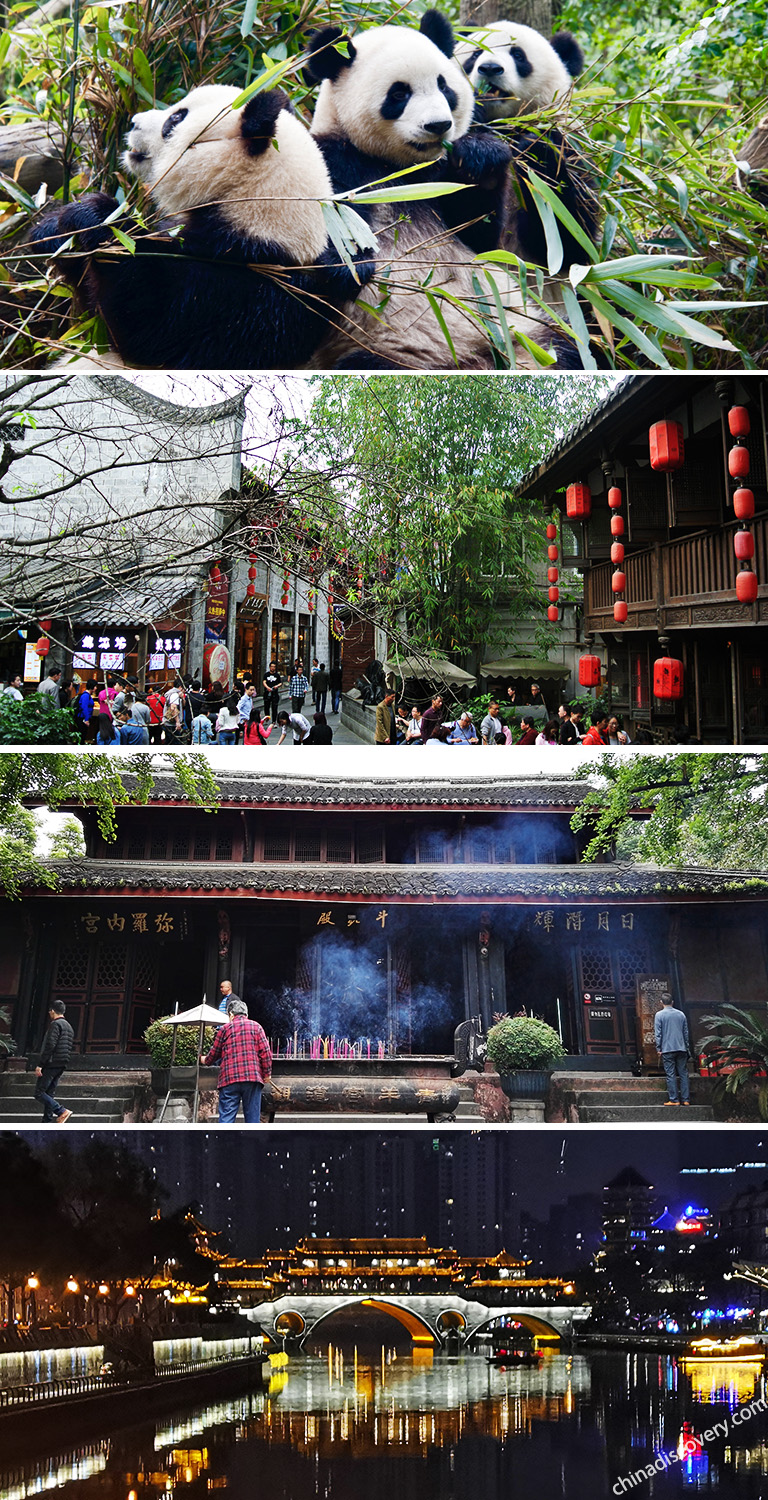 Chengdu Attractions
Chengdu Attractions
Top 3 Chengdu tours chosen by most customers to explore Chengdu in the best way. Check the detailed itinerary, or tailor your own trip now with us.
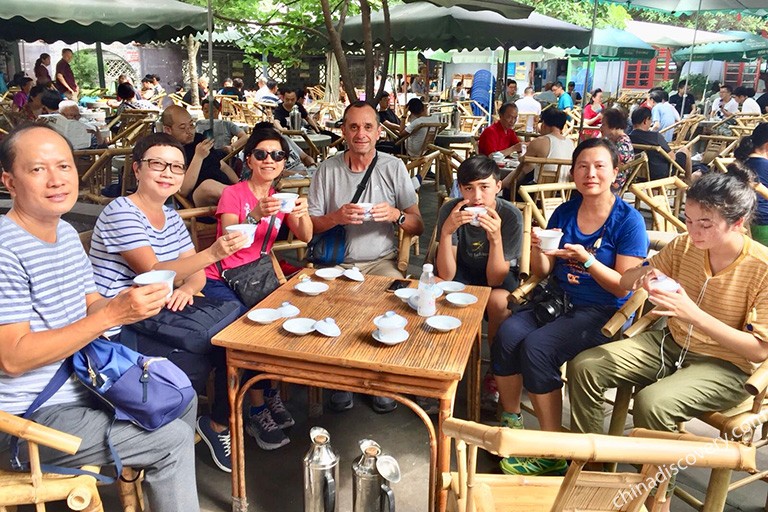
Chengdu: Jinli Street, Giant Panda Base, Wenshu Temple
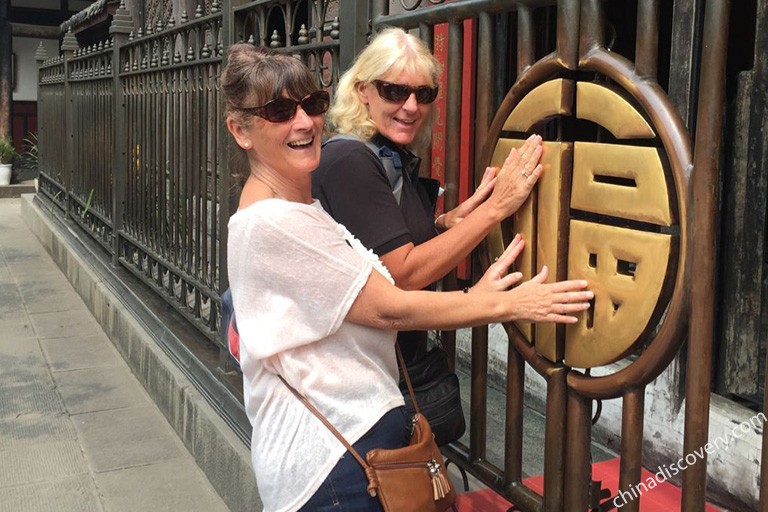
Chengdu: Chengdu Panda Base, Leshan Giant Buddha, Jinli Street
Start planning your tailor-made holiday to China by contacting one of our specialists. Once inquired, you’ll get a response within 0.5~23.5 hours.
Customize a TripFollowing are latest questions and answers from our webusers and customers. You can learn many useful information from the discussion and cases. You can also join in the discussions or ask your own question. Our experts will help you ASAP.